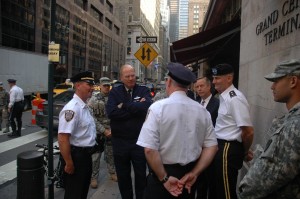Guard Bureau Chief Meets Troops in Big Apple Joint Task Force from NY National Guard Provides Security Assistance in New York
| DMNA Home page | More News Stories |
Story by: PFC Ubon Mendie - New York Guard
Dated: Fri, Aug 27, 2010
NEW YORK -- The Chief of the National Guard Bureau visited New York City to meet with Soldiers and Airmen of Joint Task Force Empire Shield and was briefed on how the New York National Guard supports law enforcement agency partners in terrorism deterrence and response here Aug. 26.
General Craig R. McKinley was joined by New York Adjutant General Maj. Gen. Patrick Murphy and New York Metropolitan Transportation Authority Police Department Commanding Officer of the North Region, Assistant Chief Stephen Conner during a visit to the busy Grand Central rail station.
McKinley began his visit with a tour of Grand Central Terminal, where he met and greeted various members of Joint Task Force Empire Shield who were posted throughout the terminal, partnered with the Metropolitan Transit Authority (MTA) police force during a security surge mission. Task Force Empire Shield’s 250 Soldiers and Airmen constitute a full-time security force on State Active Duty in the metropolitan area.
He also visited the New York City Office of Emergency Management operations center in Brooklyn to learn about citywide preparations and response planning.
The New York National Guard has had a force in New York City continuously since September 11, 2001. Over the past nine years, the mission has evolved and matured to provide the city with additional security forces at all major locations, including a maritime presence by elements of the New York Naval Militia.
The most important aspect, explained Lt. Col. Greg Driesbach, the commander of the task force, was the working relationship between the New York National Guard and its agency partners throughout the city, which span from the NYPD and FDNY to state and federal representatives from the Office of Homeland Security.
McKinley asked the troops and their leaders for a frank assessment of their training, equipment and preparedness to support civil authorities.
“I don’t command these great National Guard forces,” McKinley explained to the law enforcement leaders, ‘but I am their strongest advocate for resources out of Washington. If there’s something they need, I need to know.”
McKinley met with Lt. Col. Kaarlo Hietala, the commander of the 24th Civil Support Team located at Fort Hamilton. The team recently completed its validation for full employment as a Chemical, Biological, Radiological, Nuclear or High Explosive (CBRNE) response team. The CST trains to support civil authorities and for the 24th, that means the FDNY, NYPD , Port Authority and a multitude of city, state and federal agencies.
For the 24th CST, Kietala explained to General McKinley, “there are multiple challenges working in an urban environment to include high rise buildings, rail and subway systems, as well as the ports of New York maritime setting.” All involve both unique training requirements and resources for the National Guard to support, especially the modernization of CST equipment nationwide.
“You guys here in New York are on top of this,” he added. “You are integrated full up with your agency partners. It really doesn’t get any better than this, in my opinion.”
The Guard Bureau Chief said that the impression from his talk with Soldiers, Airmen and law enforcement officials reinforced his confidence in learning what works best and applying Guardsmen when and where they’re needed, before, during and after a disaster or major incident.
“When I go back to Washington and the Pentagon, I can point to New York as an example of how the Guard makes its mission relevant and resources it.”
“New Yorkers are concerned enough about this to put their money where their mouth is,” McKinley said.
The City of New York, with a robust emergency planning section, reviewed current plans for emergency response that potentially includes National Guard elements. Most involved scenarios requiring substantial response and even larger recovery forces, much like the sustained effort near Ground Zero in the weeks and months after the terror attacks at the World Trade Center nine years ago.
“We have learned one thing since September 11th,” McKinley said, “and it is that we must depend on each other for the size of the force necessary to do these missions.”
“We (the National Guard) want to ensure that we’re value added to civil authorities and that incident commander,” McKinley said.
URL: https://dmna.ny.gov/news/?id=1282930119
216.73.216.31
Page Last Modified: Fri, Aug 27, 2010




